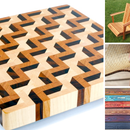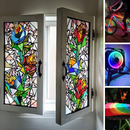Introduction: Embroidery 101: How to Embroider
This instructable will teach you the very basics of hand embroidery. Learning to embroider is not as tough as you might think! With a bit of practice, you'll get it down in no time. Plus, embroidery is a nice relaxing thing to do after a long day if you're a lover of crafting while watching TV or listening to podcasts - most of my nights are spent embroidering! :D
In this instructable, I'll cover running stitch, back stitch, split stitch, satin stitch, stem stitch, french knots and seed and fill stitches. These stitches are the backbone of embroidery - there are loads more advanced stitches out there, too. Once you've mastered the embroidery stitches in this instructable, I really recommend googling or going to the library to learn more stitches. They're addictive.
Here are some other embroidery tutorials to get you started. Head to the last step for even more!
- how to transfer embroideries to fabric
- embroidery hoop picture frames
- Legend of Zelda embroideries + pattern
- turn embroideries into wall hangings

If you like this instructable, please check out my Hand Embroidery Class!
I'll teach you everything I know about embroidery, making patterns and more. :D
Step 1: What You'll Need to Start Embroidering
To start embroidering, you'll need the following items:
- embroidery hoop - this is a ring consisting of two parts. You put the fabric in between the hoops - this helps keep it taut, making the embroidering easier. These come in plastic and wood - I prefer plastic for doing the embroidering and wood for displaying the embroideries.
- small, sharp scissors. You can find these under many names - though a google search for "embroidery scissors" will get you what you need. :D
- your fabric of choice! Linen, quilting cotton, canvas and osnaburg are all great choices! It should not be too loosely woven or too tight.
- embroidery floss. This is cheap and comes in TONS of colors. I prefer DMC floss and use it exclusively.
- embroidery needles. These have bigger eyes than normal needles to accommodate the size of the floss.
- a water soluble marker or other marking tool. This way you can draw designs onto your fabric! It's best it you use a water soluble pen so you can rinse the markings out with cold water at the end.
- whatever fabric you like! Muslin, quilting cotton, canvas and linen all work well. I typically embroidery on a linen blend.
Step 2: How to Use an Embroidery Hoop
Embroidery hoops come in many flavors, though the basic circular wood and plastic ones are the most common. You can find them at most craft stores. :)
Cut a square of fabric slightly larger than your hoop.
To start, loosen the screw at the top of the hoop. You'll then separate the hoops. Place the outer hoop to the side - we'll worry about it in a second!
(If you're using a plastic hoop, the inside hoop will have a lip. This lip can come over the top of the hoop OR hang below the bottom. Your choice! See the last photo for how I assemble my plastic hoops.)
Lay the piece of fabric over the plain inside hoop.
After you have the fabric over the inside hoop, push the top hoop down over the inside one. This will sandwich the fabric between them. Now you'll want to tighten the screw a bit and begin pulling the fabric taut. The fabric floating between the hoops should not give very much - this will make the embroidering much more complicated than it should be.
After the fabric is taut, keep tightening the screw until it feels secure to you. But not so tightly you can't budge it! You'll regret that once you've embroidered for a couple hours and your sore fingers can't open the hoop. ;)
Step 3: Threading the Needle and All About Floss
Needle threading can be a little complicated at times. I've found the easiest way to do it is to wet the very end of the floss (yes, put it in your mouth.) and squish it between your thumb and forefinger. This will flatten it out and allow it to pass through the eye of the needle with less fuss.
Also: keep in mind that you do not double the floss as you sometimes do with thread. You're simply going to pull the thread through the eye and let a few inches hang loose. You'll knot the other end as usual. (And make sure to cut off the loose stuff after the knot - it'll make your work neater! Never leave more than 1/2 inch behind the knot, or it'll get tangled while you stitch.)
Most floss is multi strand. The most common is six strands. You can divide the floss for more detailed work. The best way to do this it to use your fingernails to separate the strands and then pull is apart slowly. :)
Step 4: How to Do the Running Stitch
Done just as it is in regular sewing. You can make the stitches long or short or randomly placed depending on your design.
I use this stitch for framing and embroidery design, or for things that I want to seem open and airy. I don't recommend this as much for text, because it can be a little too spacey.
You can either do the standard up and down, or push the needle through and make several stitches at once. For new embroiderers, I recommend using the up and down method just until you get the hang of spacing. :)
Step 5: How to Do the Backstitch
I use this stitch all the time for text. It makes the text easier to read and it's more uniform. I also use it for any outlines on drawings because it makes the outlines nice and crisp.
I use a slightly altered backstitch for embroidery - it keeps the back neater and leaves less dark lines that show through to the front.
Here's how to backstitch for embroidery:
- Bring your needle through to the front of the fabric and take a stitch to the right.
- Bring the needle back to the front of the fabric a stitch length to the right and then pass the needle through to the back of the fabric using the hole at the end of the first stitch. (As shown in the second photo)
- Use the hole at the end of the farthest right stitch to bring the needle back to the front of the fabric.
- Repeat until you're done!
You can backstitch to the left or the right - but try it to the right first to get the rhythm down. As long as you keep your stitches even lengths it will look great!
The most important thing about backstitching is to make sure you're using the hole that forms at the end of a stitch to start the next stitch anytime you can. Take a look at the back of my back stitch - see how everything is nice and neat? That's what you want. You'll use less floss that way and keep everything nice and organized.
The pictures will probably help make more sense of this! ;)
Step 6: How to Do the Split Stitch
This is a great raised decorative stitch. It can be used much like a backstitch and works much like one.
I use this when I want things to have a little bit of texture. For example: the frosting on a cupcake, tree tops, flowers, outlines of fuzzy animals, etc.
For this stitch you'll pull the thread up and make a small stitch (no bigger than a grain of rice works best!). You'll then come back up through the middle of that stitch and take it back down through the fabric a short distance away in the direction you're going in. It's best to keep your stitches pretty short (1/8 of an inch to 1/4 of an inch.) when doing this - otherwise your stitches look messy and they won't conform to curves as much as you'd like.
See the pictures for extra help! :D
Step 7: How to Make a French Knot
French knots are considered to be a nightmare for most embroiders, but I love them. They're very delicate and cute and they never look the same.
Their size can also vary greatly, so you can use them in a ton of ways. (Check the first photo - the top row is French knots made with six strands of floss wrapped once, the second row the knots are wrapped twice!) You can use them for the center of flowers, as eyes, for polka dots, and even as lines if you're feeling patient. :D I use them most often while dotting i's in text.
To pull off a french knot successfully, you'll need to follow these steps:
- pull the floss through to the front of the fabric.
- wrap the floss that's between the fabric and the needle around the needle 1, 2, or 3 times. (One time is a small knot, 2 is medium, 3 is large.)
- hold the floss tightly so that it is wrapped around the needle.
- with your other hand, push the needle through to the back of the fabric very close to where the floss emerged.
- keep holding the floss taut and pull the needle all the way through.
- practice this a few hundred times until it becomes second nature. :D
You'll knot these on the back as normal. For the cleanest work (if you're not making loads of them!), tie off between each french knot. Otherwise, you'll have tails everywhere if the knots are spread out!
Step 8: How to Do the Stem Stitch
The stem stitch is fantastic for vines, branches, flowers and outlines. It also looks great for text, but you've gotta be careful with sharp corners.
A stem stitch is similar to a backstitch, but instead of linking stitches at the ends, you're going to instead bring the needle up for the next stitch right next to the last stitch.
Make a small stitch about the length of a grain of rice. Bring the needle back up through the fabric on the right or left side of the previous stitch, fairly close to the end of that stitch as shown in the second photo. Keep starting your new stitches on the same side of the stitches you're already put down.
This stitch is easiest to practice with lines drawn - when you try it without lines it can be tricky to know where each stitch should end.
Step 9: How to Do the Satin Stitch
Satin stitch is great for adding big splashes of color to your embroideries - filling in letters and shapes and all kinds of things!
Satin stitch can be done in many ways. You can outline a shape with backstitching and then fill it in. You can do satin stitch on its own with no outline. You can also backstitch an outline and then satin stitch completely over it to get a slightly raised area.
To practice satin stitch, first draw a simple shape on your fabric. Then use a backstitch to outline it. Then you'll simply go back and forth across the shape (I always like to start in the middle, but it's personal preference.) until it's filled in.
Try it again using the other two methods!
The two most important things about satin stitch are:
- getting as close as possible to the outlines so that your satin stitch looks nice and full - you can always go back and fill in those bald spots with seed and straight stitches, but it's easier to get it right the first time!
- don't continue your satin stitch on the back of your work. It'll waste your embroidery thread and make your work bulky! To avoid this, bring you thread to the front for the first time right next to the outline on the left. Then, bring it across, and down next to the right outline. Instead of crossing over to the left side of the outline on the back of the fabric, just bring the needle right back up next to where you just pushed it through. That way you're saving thread and time. :)
Step 10: How to Do Straight and Seed Stitches
These are similar to running stitch - you're just not following a line! The placement is normally very random.
Straight stitches can vary in length and are wonderful for filling in areas with loads of texture. Seed stitches are very tiny - you'll be catching just a few threads with these! Seed stitches are most often used to fill areas in. Straight stitches can be used for a ton of different things - filling things in, adding detail, shading, etc.
See the pictures for a quick example.
Step 11: Additional Information and Recommendations - and Some Embroidery Photos!
The stitches in this instructable are just the beginning! I've included lots of photos of my embroideries just so you can see what you can do. I use the backstitch waaaaaayyyy too much - it's my crutch! I'm trying to get better about it, though. :D
Creating your own embroidery patterns
I've also published an instructable over how to transfer embroidery patterns, which should be useful if you're just starting out!
To create a pattern, you can draw on the fabric (there are water soluble markers!), or use iron on transfers or carbon paper to copy a design onto the fabric.
Embroidery supplies and tools
As far as shopping for supplies and patterns, you can check your local craft/sewing retailer or try these websites:
- https://www.createforless.com/ - I buy my hoops here, floss too sometimes.
- http://www.sublimestitching.com/ - They have great beginners kits!
- http://www.etsy.com/ - Loads of special hoops and patterns
- http://www.eatdrinkstitch.com/ - If you're in the Kansas City area, you can go to local stitching events! The blog also has loads of great content and more tutorials!
Instagram embroidery
Instagram has a HUGE embroidery community, so I recommend getting involved there! Here's my profile - check out the list of folks I'm following to find some amazing artists. :D





